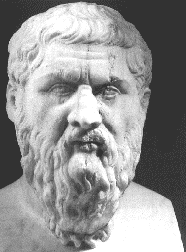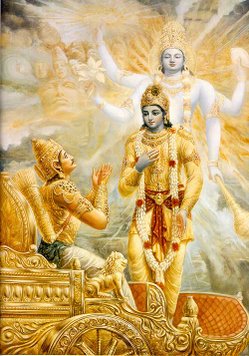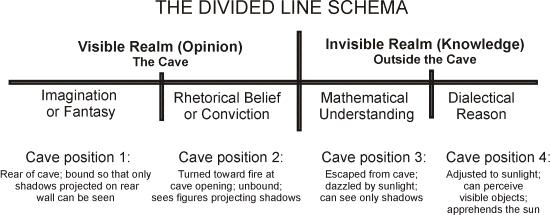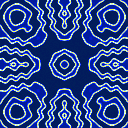One of Plato's most important contributions to Western thought was his conception of Forms (ideai, eide). Plato saw ultimate reality composed of two distinct "worlds" or dimensions of being. The world of physical objects in space and time is known through sense perception and ordinary thought. Apart from this is the nonphysical, nonspatial, nontemporal, universal, eternal supersensible world of Forms known only through philosophic reflection--beyond ordinary experience and requiring special capabilities to apprehend.
To explain what he meant by Forms, Plato referred to such entities as "table," "triangle," "justice," "beauty," and "the good." "Triangle," for example, is that supersensible entity which is known by a geometrician when he examines physical triangles drawn in chalk or ink or referred to in ordinary thought as "a plane figure enclosed by three straight lines."
Physical triangles are representations on blackboards, pieces of paper, or computer screens of the Form "Triangle," which has non-material being in a supersensible dimension. So while a physical triangle is never identical to the Form "Triangle" it does have some resemblance and can help us reflect on, search for, and discover the Form. The Form "Triangle" is universal and supersensible, not just a physical entity at a particular time and place.
In the dialogue Meno, Plato describes a form as the "common nature" possessed by a group of things or concepts. Speaking of virtue he says:"And so of the virtues, however many and different they may be, they have all a common nature which makes them virtues; and on this he who would answer the question, 'What is virtue?' would do well to have his eye fixed."The Forms are eternal and changeless, but enter into a partnership with changeable matter to produce objects and concepts we perceive in the physical world. Physical objects are instantiations, expressions, or manifestations of the Forms and are always in a state of change: becoming and expiring, moving in space, evolving, etc. Since the ever-changing temporal world participates in a succession of Forms, it can only be the source of opinion, not knowledge. Plato likens the opinions derived from our senses to the perception of shadows of real objects cast upon the wall of a cave. True knowledge, however, is the perception of the archetypal Forms themselves, which are real, eternal, and unchanging.Plato distinguishes between the two worlds in terms of what kind of knowledge is possible in each and what entities are used to gain this knowledge. In reference to the higher, supersensible world, we have a Higher Self or Soul which enables us to to gain true understanding and genuine knowledge. The bodily senses and the ordinary intellect which report about the physical world, provide only belief and opinion. Plato provides further explanation in the Commonwealth.
"When its [the soul's] gaze is fixed upon an object irradiated by truth and reality, the soul gains understanding and knowledge and is manifestly in possession of intelligence. But when it looks towards that twilight world of things that come into existence and pass away, its sight is dim and it has only opinions and beliefs which shift to and fro, and now it seems like a thing that has no intelligence. . . .While Forms are invisible to the eye, our souls have participated in the eternal world of Forms prior to our incarnation in a physical body and retain a memory of them. Although this memory is not readily accessible to the conscious mind, its presence can be discovered through a special methodology of dialectic and analysis of perception. Plato maintains that the philosopher can achieve the capability of perceiving the Forms directly, with his "mind's eye," by:
"This, then which gives to the objects of knowledge their truth and to him who knows them his power of knowing, is the Form or essential nature of Goodness. It is the cause of knowledge and truth; and so, while you may think of it as an object of knowledge, you will do well to regard it as something beyond truth and knowledge and precious as these both are, of still higher worth. . . . So with the objects of knowledge: these derive from the Good not only their power of being known, but their very being and reality; and Goodness is not the same thing as being, but even beyond being, surpassing it in dignity and power."Thus Reason or Higher Thought is able to construct a hierarchy of Forms, to scale to the height of first principle and attain a state of true knowledge.

- Developing skill in discerning the conceptual qualities common to groups of things and ideas in the temporal world
- Realizing that these are merely hypotheses
- Employing the method of dialectic to categorize and group the qualities in their correct relationships and order
- Using the hypotheses as stepping stones to further hypotheses
Plato viewed the unchanging world of Forms as constituting a system of eternal principles emanating from Absolute Good which the present world merely shadows. Hence, Plato's Commonwealth, his discussion of the Idea of Justice, delineates the need for a commonwealth to be led by Philosopher-Kings who through their education are prepared "to know the Good through rational insight and embody its ideals by ruling directly over the social order."
Explications of Forms in Other Perennialist Literature To assist in understanding the complex nature of Forms, we'll examine three explanations outside Plato's writings:
- The Bhagavad Gita
VII:7 "All the worlds have their rest in me, as many pearls strung on a string.""The simile is one of faith, but not of blind faith. One of the points is, that the string is invisible, being hidden by the pearls strung on it. But a second point is that the string is known to be there; otherwise the pearls would not remain in order but would be scattered. In the same way the order of the world shows that there is an underlying intelligence which holds it together, which integrates it."
Trevor Leggett, Realization of the Supreme Self: The Bhagavad Gita Yoga-s
 VII:10 "And I am from everlasting the seed of eternal life. I am the intelligence of the intelligent. I am the beauty of the beautiful."
VII:10 "And I am from everlasting the seed of eternal life. I am the intelligence of the intelligent. I am the beauty of the beautiful."Here the Form, manifesting as Krishna, is the Godhead speaking. How marvelous is the thought that the Divine Form IS the beauty that we see in many different beautiful entities: people, nature, deeds, and ideas. He is that Higher Element of intelligence which we see shimmering in intelligent people, intelligent interchange, and intelligent behavior. The Higher Essence of all particular beautiful things is Beauty.
Boethius, The Emboldenment of Philosophy "Now, no one can deny that something exists which is a kind of fountain of all goodness; for everything which is found to be imperfect shows its imperfection by the lack of some perfection. It follows that if something is found to be imperfect in its kind, there must necessarily be something of that same kind which is perfect. For without a standard of perfection we cannot judge anything to be imperfect."
Ernst Cassirer, The Platonic Renaissance In England "The act of consciousness requires rather an original spontaneity from which alone it can arise. The flux of sense-impressions must be referred to and measured by fixed and enduring thought-patterns. [Forms] It is only because we can think such unified existences, that we are able as it were to bring to a standstill the abundance of individual images in the mind, and relate them to, and compare them with, one another. No sense-object could for instance be recognised as a triangle and called such, unless thought were able to grasp the pure essence [Form] of the triangle and embrace it under a general definition. If judgment is to be possible, and therewith the beginning and seed of all knowledge, then a sensible subject must always be connected in this way with a conceptual predicate, the particular with the general, and the perceived or imagined with the purely abstract. The image in 'phantasm' is meaningless without the idea of 'noema' [Form] by which it is determined and given significance. All true cognition is such an attribution: the recognition of originally known essence in the single instance or special case."
Forms As Portals to the Supersensible World To understand how Perennialist teachings concerning Forms provide an entrée to a supersensual world, we must begin with the most fundamental questions. Why is our physical world not governed by incoherent chaos? Why is this "Cosmos" (as the Greeks termed it) intelligible to humans? What is the essence of these organizing principles: "pattern," "structure," "form," and "order?"
Pythagoras and Plato believed that elements in our empirical world are ordered by supersensual Forms residing in a higher dimension. These Forms were necessary to explain the structure we see in the world around us. The only reason the physical universe is intelligible at all is that objects retain the same form, different things take on the same form, and we are able to communicate with one another about the meaning of these patterns and relationships.
Our bodies, for example, undergo complete change within a seven year cycle--every atom being replaced by new atoms. How is it that we retain the same form when everything substantial has been replaced?
Why is it that completely different objects are somehow "the same" with respect to this or that organizing principle: (height, color, chairness, etc.)? No one would doubt that two chairs are somehow instances of the same thing: the form Chair. But how can two things made of completely different physical stuff, two things that are not identical, be the same with respect to Chairness, but different with respect to, say, Height?
It's easy to just shrug these fundamental questions off and say that the existence of similarity needs no explanation; it simply is. But we must ask:
- How is it that we can tell that things are the same?
- How can we recognize that things have distinct forms?
- What is the nature of these Forms in which physical objects participate?
Pythagoras and Plato believed that Forms are neither material objects, aspects of material objects, nor mere concepts in our brains--they exist on their own terms, apart from the physical universe, eternal and immutable. Physical objects are what they are by virtue of their participation in specific Forms.
Aristotle maintained that these Forms are merely "aspects" of physical objects and have no separate being in a supersensual world. Modern scientists such as Rupert Sheldrake have come up with theories similar to Aristotle, seeing forms as merely constituents of objects. Sheldrake called this process of retaining the same form "morphic resonance."
Most modern scientists ignore supersensible questions about the essence of Forms. But we cannot avoid this question if we take seriously what Perennialist teachers have maintained: that humans have the capacity to attain a higher state of consciousness through understanding the supersensual world of Forms or Ideas.
"Within the human consciousness is the unique ability to perceive the transparency between absolute, permanent relationships, contained in the insubstantial forms of a geometric order, and the transitory, changing forms of our actual world. The content of our experience results from an immaterial, abstract, geometric architecture which is composed of harmonic waves of energy, nodes of relationality, melodic forms springing forth from the eternal realm of geometric proportion."
Robert Lawlor, Sacred Geometry
Spiritual Geometry
Mathematics and especially geometry were seen by such Perennialist teachers as Pythagoras and Plato as among the most effective means of understanding and entering a spiritual realm composed of eternal, unchanging (invariant) Forms or Ideas. In Plato's Commonwealth, Socrates says that only those versed in geometry will be allowed entrance into the ideal state.
"For Pythagoras, mathematics was a bridge between the visible and invisible worlds. He pursued the study of mathematics not only as a way of understanding and manipulating nature, but also as a means of turning the mind away from the physical world, which he held to be transitory and unreal, and leading it to the contemplation of eternal and truly existing things that never vary. He taught his students that by focusing on the elements of mathematics, they could calm and purify the mind, and ultimately, through disciplined effort, experience true happiness."
John Strohmeier and Peter Westbrook,
The Life and Teachings of Pythagoras

